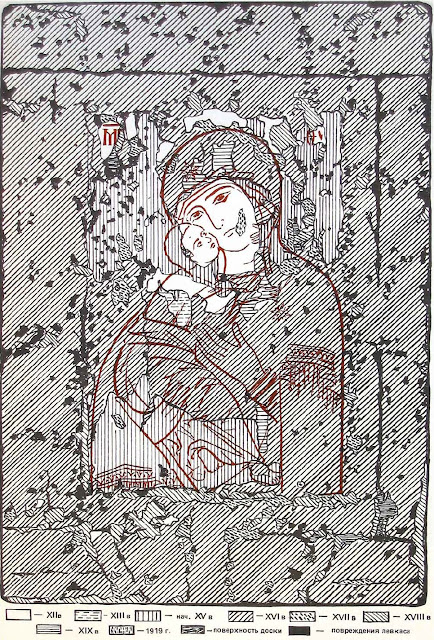The Virgin of Vladimir is the most famous and most revered of Russian icons, described as the "Palladium of Russia" (a protective sacred image), it is also among the oldest of all surviving Russian icons. It is older than Russia itself, made for Kievan Rus, a loose collection of principalities from which Ukraine, Russia, and Belarus would emerge. The Virgin of Vladimir is one of only twenty surviving icons from before the Mongol invasions of the 13th century. All twenty of those surviving icons were made in or for Kyiv in the 11th and 12th centuries.
A 12th century Kievan prince commissioned the Virgin of Vladimir for a church he was building from the imperial workshops in Constantinople. When the icon arrived in Kyiv about 1131, it created a sensation. It was celebrated and famous from the start. It was as celebrated for its beauty as much as for its sanctity. It remains a major masterpiece of Byzantine painting with an emotional appeal unusual for Byzantine art in any era. The unknown Greek artist of the Virgin of Vladimir may have invented this type of composition showing a tender contact between mother and child later known as an Eleusa Icon type. No other icon painter since invested that tender cheek to cheek contact with the warmth, depth, and complex range of emotion that this artist created in the Virgin of Vladimir.
This restorer's diagram shows how very little is left of the original icon. Only the two faces remain from the original painting. The rest is the remnant of several re-paintings over many centuries. The great icon painter Andrei Rublev is said to to have had a hand in restoring this painting at one time. Like so many ancient revered sacred images, the Virgin of Vladimir was worshipped almost to death.
A detail showing the remaining portions of the original painting from Constantinople.
The icon did not remain in Kyiv for long. In 1167, the Virgin of Vladimir traveled to the city of Vladimir where she resided for about a century. The icon was transferred to Moscow in the 14th century where it remains today.
The Virgin of Vladimir was so revered that there were icons painted about it. Here is a 16th century icon commemorating its 1167 arrival in the city of Vladimir from which it would take its name. A monastery was later built on the site of the transfer.
One of the reasons for the icon's poor condition is the addition of pious ornamentation over the centuries. All of this was added with the best and most reverential of intentions, but it badly damaged the original painting every time such ornament was added and removed.
The riza, or oklad, or as it's known English, the revetment above was made in the 15th century specially for the Virgin of Vladimir, as was the 17th century riza below.
These pious ornaments are themselves works of art.
Here is a copy of the Virgin of Vladimir made in the 16th century for Irina Godunova, sister of Boris.
It remains fully vested. This is how people would have seen the Virgin of Vladimir for most of its history, vested and surrounded by flowers and candles.
The Virgin of Vladimir inspired innumerable copies and imitations down through the centuries.
This one is among the most famous, the Donskaya Virgin by Theophanes the Greek (or Feofan Grek in Russian), one of the very few icon painters who was neither ordained nor in religious orders.
Rumor has it (and I don't think a very credible rumor) that Stalin had the icon flown around city in a plane during the Battle of Moscow in 1942 to defend the city from the Nazi armies at its gates. Stalin was many things, but I doubt he was so credulous. But that story points to a significant role played by this icon as a protective image of the city of Moscow and of Russia.
The icon arrived in Moscow in 1395 to defend the city from the predations of Tamerlane. Tamerlane spared the city and retreated. And so did the Nazis in 1942. They never entered the city. So who knows.
Until 1930, the Virgin of Vladimir resided in the Cathedral of the Dormition in the Kremlin in Moscow. After that the icon hung in the Tretyakov Gallery as a work of art and historically significant artifact.
In 1993, the icon was moved to its present location, The Church of St. Nicholas in Tolmachi where the Tretyakov Gallery and the Metropolitan Patriarch of Moscow share custody.
The Church of St. Nicholas Tolmachi
Interior of the church where you can see the Virgin of Vladimir on display to the left.











No comments:
Post a Comment